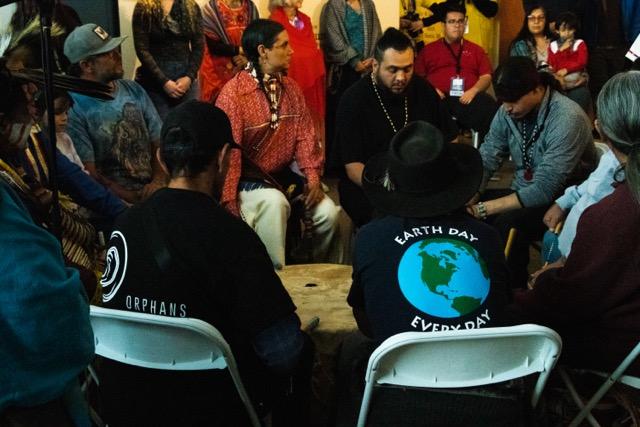
For some people, Saturday mornings consist of small talk, breakfast, news reading and strong cups of coffee. But on Feb. 27, some people at Colorado State University-Pueblo were having conversations regarding graph theory, abstract algebra, calculus, geophysics and the history of mathematics.
Almost 150 students from around the state and 12 different institutions, gathered in the CSU-Pueblo General Classroom Building for the thirteenth annual Pikes Peak Regional Undergraduate Mathematics Conference.
According to its organizers, this is a conference that would not be here and these are conversations that would not be had if it weren’t for hard work and fighting for opportunities.
“It’s really important for us to have this in Southern Colorado. I’ve been on the steering committee since we started this conference and we fight hard to keep it in Southern Colorado,” said Janet Barnett, professor of mathematics at CSU-Pueblo.
Barnett is avid to jump and say no when someone in Denver wants to hold a math conference or seminar.
“Up north, there’s tons … (of) people interested in math, they’ve got lots of places they can go. There’s conferences, there’s other schools, there’s seminars and we get nothing,” she said. “Southern Colorado doesn’t have a lot in terms of state resources and this is something we can offer these students.”
A challenge that the conference faced this year as opposed to other years was the source of funding. The grant it was funded by for many years through the Mathematical Association of America ended.
“That (the conference) is not an expensive thing to run. Math is cheap. You just give us a chalkboard and we’re happy,” said Jonathan Poritz, associate professor of mathematics at CSU-Pueblo.
Funding for the 2016 conference came from the Rocky Mountain Section of the Mathematical Association of America, private donations, as well as both CSU-Pueblo and the University of Colorado at Colorado Springs, two of the four institutions that regularly host the conference.
The two other host institutions are the United States Air Force Academy and Colorado College.
Barnett said CSU-Pueblo is always the host school that has the largest attendance. In 2003, when the first conference was held, CSU-Pueblo was the host.
The majority of attendees are undergraduate students, but there are a few graduate attendees as well, since the conference is geared toward teaching students about opportunities beyond college in the mathematics realm.
After some introductory remarks, mathematician and CSU-Pueblo Provost and Executive Vice President for Academic Affairs, Rick Kreminski, kicked off the day by saying, “let the math begin.”
The focus of the conference each year is to provide undergraduate mathematics students with research, networking and learning opportunities as well as to connect with other similarly minded students from around the state. Multiple scholars give presentations about their work and findings related to group or independent, in-depth mathematics projects.
“I think for the student presenters it’s really important to have a professional setting where they can present their work and share what they’ve been thinking of in mathematics and this is a really friendly venue for them to do that in,” Barnett said.
This year, five CSU-Pueblo students presented at the conference out of the 22 total that attended from the university.
James Todd, a senior and double major in physics and mathematics, presented in the group talk and as an individual as well.
The group talk was titled “Group Learning Program at CSU-Pueblo” and discussed how the program has been beneficial to students and has helped many achieve success in college algebra. It was given by Zach Bridwell, Haven Hall, Angie Justus, Derek Moore and James Todd.
“Mathematics is a marvel in its own right and it’s really great to see passionate math students studying it in every aspect imaginable. It’s a privilege to be a part of a conference with so many students taking their studies to the next level. Quite inspiring, really,” said Haven Hall, a CSU-Pueblo mathematics graduate of 2015, who is currently studying a mathematics graduate program at the university.
Todd’s individual presentation was one he had begun working on about a year ago. He was asked to update and present it at the conference.
Titled ‘On Stable Orbits of Circumbinary Planets,’ the project delved into the topic of attempting “to find structure of stability of possible exoplanets orbiting the common center of mass outside of the binary in binary star systems,” according to the conference abstracts booklet.
“The most rewarding part is honestly the presentations and hearing from my research advisor that I would give a really good presentation,” he said.
Todd said he will be continuing work on this project and further developing it as the semester goes on.
The majority of attendees do not present, but are there for the learning experience, like CSU-Pueblo engineering junior, Dominic Schmitt.
Schmitt described the most beneficial part of the conference as “just learning about what is going on and what other professors are doing and the students.”
“I think a lot of people who are interested in math… aren’t aware that this is a community of like-minded people. There is a thriving scientific community in mathematics. We get along, we support each other,” Poritz said. “It’s a nice environment and it’s nice to have a chance to do this. We’re an even more supportive version of what is already very supportive.”










Dr. Bruce Lundberg • Mar 12, 2016 at 11:25 am
Dear Ashley,
Thank you so much for giving such a good report on our 2016 PPRUMC. Your article was well-written, engaging, factual, and honoring to our efforts to lead learning! You did us good service!
Best,
Bruce N. Lundberg, PhD
Chair of Department of Mathematics and Physics
CSU-Pueblo